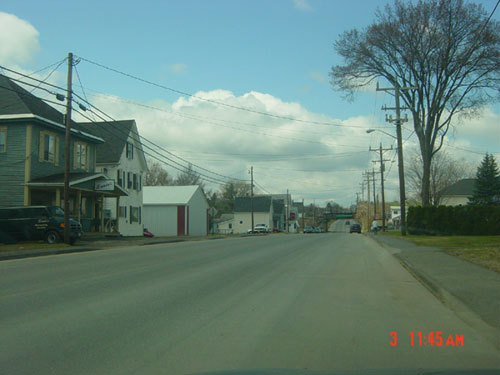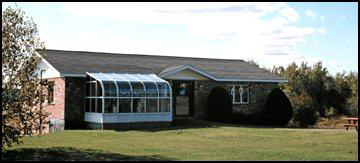- Category: Demographics
- Published on 28 March 2006
- Hits: 15123
Town of Mapleton |
|
The only known metal in Mapleton is manganese. Manganese was prospected by a company on the Higgins and Forest Dudley farm in past years, but no profitable operation was found. Some of the earliest people were the migratory Indians; they came to Mapleton to fish and hunt. Legend has it that a battle had been fought in the Haystack Mountain region by the Mic Mac and Melecite Indians, and stone implements were even found in this area. Haystack Mountain, named after Col. John Goddard, and named it haystack because of the shape (stack of hay). The location of the mountain is in Castle Hill (previously called Sugar Loaf). In the late 1600’s, an Indian tribe, called the St. Francis Indians, settled along the Aroostook River. Many lived in stone forts and huts made from logs instead of Wigwams; many spoke some French or English. They tamed caribou and reindeer as beasts of burdens or harnessed moose for traveling on the Aroostook River in the winter. They also made boats by using a basket weave, smeared with pitch to prevent leakage. In 1692, a group of English hunters and trappers along with some New York Indians, called the Iroquois Indians aks the Mowhawks, set out to exterminate the Indians and Frenchmen. The French and Indians were driven back toward Haystack. The native Indians fled leaving thirty dead warriors. Most of the fighting occurred during the summer, and with winter coming, the Indians began making raids on the English settlements in southern Maine. The captives were brought back to Aroostook County, and they were traded with agents(English) for gun powder. In the winter of 1693, a man named Martin Trudo, among others, raided a home occupied by Andrew Mullen and his family. Trudo pleaded that Andrew Mullen's beautiful daughter be spared and made her a pair of moccasins and leggings for her frozen feet. The Indian village was located in what is now called Washburn. The Mullen family except for Mary was ransomed and thus released. Because the daughter got lonesome for her family, Trudo decided to take her to the block house in Woodstock and find someone to take her home, but as fate would have it, they were captured by English hunters. Martin was killed, and Mary, being afraid of what would happen to her, killed herself. This happened in Westfield. The French and Indians were allies and fought together in what is called the French and Indian Wars against the English. In 1695, hunters once again came to Aroostook County, but they found the area as desolate. The hunters went to the Allagash, where the St. Francis tribe were, and attacked the peaceable tribe. A man by the name of John Blake on his deathbed told the story about what they had done to the Indians. After eight years of fighting, peace finally came. It was determined that each side would hold the same territory prior to the conflict. The English left and sailed to the Penobscot River where they settled. The Mic Macs and Melecites returned to Mapleton again for hunting, where they stayed until they went to the reservation at Tobique. War Knife, chief of the St. Francis tribe, aks Crooked Knife, because of his hunched back, lived to be an old man and was buried with his horse just outside the Mapleton town line. An English packet ship came to Maine in 1760 to pay the British soldiers in America. With a party of 60, they encamped for the night at the Aroostook River. The marines, with food and ammunition, depleted a letter that was written to the commander of the waiting ship. The letter was given to one of the guides to take to the ship. All the guides except the Indian were dismissed. The sacks of gold that were to be used for payment were buried under a tree. At the time, a scout hid behind a tree, and he sensed that the treasure was about to be buried. The paymaster’s message was received at the ship, but the marines were never seen again. After a couple of years, the scout and his companions went back to get the treasure, and they were never seen again either. It's doubtful if any treasure was found. It's supposedly not far from Mapleton. In 1753, John Bradley, born in Vermont, was the first permanent white settler in this area. Bradley, a hunter and scout, was chosen by Benedict Arnold to scout for food. Expecting to have lots of food for the men, Bradley came back with just a partridge. Bradley was accused of loafing, and because Bradley sassed, the commander drew his sword on Bradley. Bradley was arrested and bound to a tree. After managing to get free, he ran to the woods and found himself surrounded by St. Francis Indians. Because the Indians spoke English, he was able to tell them his story. He was taken to Chief Crooked Knife and eventually married his daughter, and because he had killed a guard while trying to escape, he could not return to his own country, so he joined the tribe. After a number of years, he and some Indians went up the river to go bear hunting, and they never returned. Sadly, he left a large family of children behind. The land was now owned by the British government. The tall trees were marked and to be used only for ship masts for the navy. A penalty of three months in prison was incurred if the trees were cut or destroyed. In 1819, Peter Bull, with 600 acres of land patent from the New Brunswick government, settled at the mouth of the Presque Isle and Aroostook River; it reached to the corners of Mapleton and Chapman. With help, a dam and mill were built. This venture was not real successful at this time because of the lack of demand for lumber, so he started growing potatoes and oats for a living. As a result, some of Mr. Bull’s relatives from New Brunswick settled a few miles from him. With the treaty of 1842, land grants and U.S. citizenship were finally granted for the relatives. The homes were mostly log cabins; the fireplace was often the source of light other than pitch pine torches and tallow candles. Sheep were finally able to survive as a result of the wolves being trapped. There were no schools, doctors, or lawyers in 1820. Peddlers and preachers did come but mostly from the St. John River. In 1827, Alexander Freeman, an agent for the State of Maine, was sent to find out if there was any reason for Maine to fight for Aroostook County; he posed as a peddler so he could do his job without anybody knowing. He got everybody's name by visiting every cabin, and he returned to Portland stating the area was definitely worth the fight. This gave Mapleton it's first road in 1842 called the State Road; it also proved that Mapleton was not a part of Canada but a part of the United States. People returned to Mapleton with more of their Canadian relatives as well. As the timber market fell, people turned to a living of making cedar shingles and farming. Lots were granted to people if they lived on the lot for six years. Some of the lots that were granted are names still familiar to us with last names: Christie, Erskine, Churchill, and Bull. Food was very precious, many of the early settlers, who ate bear meat, used the skins for rugs or clothing and fat for frying. If you were given 400 acres of land during this time, it meant you were building a new mill. Aroostook County had the reputation of being an excellent place to raise crops and a healthy place to live.
The town was called Mapleton because of the many maple trees. The areas, Chapman, Castle Hill and Mapleton have excellent snowmobile and ATV trails. This area has it's own elementary school, and it is also an excellent place to bring up a family. |
|


 It took 10 days to get any needed machinery from Bangor. People who were known as “Outsiders or Kennebeckers” came to this area because Aroostook County had the reputation of having land with seed starting to grow the next day, and it was an excellent place for your health as well. The large pumpkin pines of the area brought people into the territory. There were other saw mills that were built there, and the ownership also changed. A forest fire, however, burned the mill along with much of the town in 1887. There were other early settlers with names that can still be recognized in the area.
It took 10 days to get any needed machinery from Bangor. People who were known as “Outsiders or Kennebeckers” came to this area because Aroostook County had the reputation of having land with seed starting to grow the next day, and it was an excellent place for your health as well. The large pumpkin pines of the area brought people into the territory. There were other saw mills that were built there, and the ownership also changed. A forest fire, however, burned the mill along with much of the town in 1887. There were other early settlers with names that can still be recognized in the area. Central Aroostook Chamber of Commerce
Central Aroostook Chamber of Commerce Mapleton
Mapleton